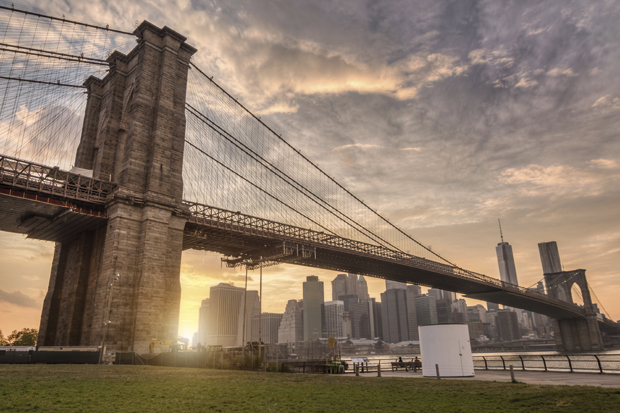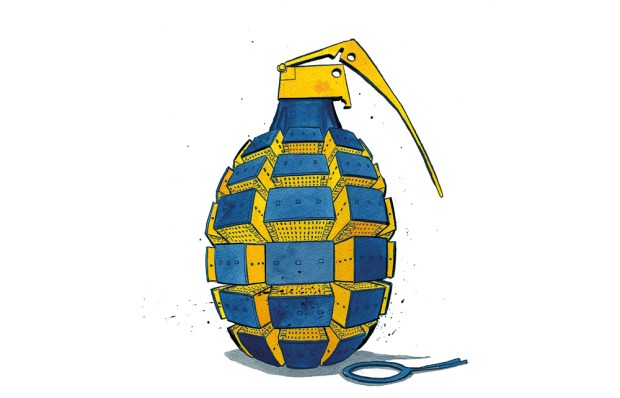Deep below West 52nd Street is a massive stash of booze.
The cops never found it during Prohibition, and it belongs to the 21 Club. Famous for its sumptuously New Yorky dishes (like filet mignon with kumquat vinaigrette), 21 is a real boys’ den. Dark and plush, the subterranean rooms are festooned with intriguing junk: footballs, helmets, a model torpedo boat given by JFK, and a smashed racket from McEnroe. There are even 25 paintings by Remington, left by debtors during the depression. But oddly it isn’t a club at all. Anyone can go there, provided they’ve got a fat wallet and hollow legs. You just need to book (www.21club.com; 212 582 7200), otherwise you’ll be slugging it out with a banker.
‘How did you hide the booze?’ I asked. ‘I’ll show you,’ said the wine steward, and led us off downstairs, even deeper underground. There, he produced an 18-inch meat skewer, and slid it into the brickwork. With a distant clunk, two-and-a-half tonnes of wall swung to one side, revealing a cavern big enough for 2,000 cases. It’s still a private stash (for movie stars and presidents). In the kitchen opposite, even the cooks looked slightly guilty, and sprang to attention as we passed through. It was here, in 1931, that a gangster’s moll famously had it off with a talented young writer. He, of course, was the irrepressible Ernest Hemingway.
And it’s these writers that intrigued me. What is it about New York that’s made it such a literary hothouse? Everyone seems to have been this way, boozing and scrawling: Stein, Steinbeck, Thurber, Miller, Mailer. Often the books have had nothing to do with the city: Kerouac wrote On the Road in the Bowery (while emphatically ‘off’ the wagon) and In Cold Blood emerged from a pretty little brownstone. Often, too, New York has spawned books about distant, unimaginable worlds, like The Last of the Mohicans, written in the East Village, or Under Milk Wood in the Chelsea Hotel. Writers have always liked the hotels. The Chelsea also hosted Twain and Arthur Miller, and Tennessee Williams enjoyed the Elysée so much that he stayed for 15 years, only checking out in his coffin.
I was curious as to what had become of these old haunts, so I set off on a literary ghost tour. I didn’t expect to find much. After all, Eugene O’Neill’s birthplace on Times Square is now a Starbucks.
I began (where 17 million Americans began) at the old immigration station on Ellis Island. It’s a weird mix of palace and prison. Between 1892 and 1917, it was a portal of hope, beckoning in the outside world. Strangely, there were few literary ghosts on the manifests, although I did spot Joseph Conrad (just visiting).
I had more luck over a $25 sandwich at the Algonquin, on West 44th. In its hallowed Edwardian lobby, it was easy to imagine the city’s earliest celebrity writers: Scott Fitzgerald, Dorothy Parker and her vicious circle. They’d even left a few artefacts in glass cabinets. But, for me, one man’s majestic is another man’s funereal. I doubt all that dark varnish and polished brass has sparked much creativity in recent years. We needed a literary hotspot.
Surprisingly, one of the hottest spots is across the East River. I loved Brooklyn Heights, with its maple-shaded streets and huge, chocolatey mansions. It has about it something of the stage set. Perhaps it’s the dearth of cars, or the improbable banana-yellows, or the sprawling backdrop of Manhattan. And behind the lace, it’s heaving with ghosts. Between Ramsden and Orange Street is a tiny enclave that produced Breakfast at Tiffany’s, Death of a Salesman, Tropic of Cancer and The Naked and the Dead. We also found W.H. Auden’s gloomy apartment. Back then, in 1939, it was so cold that the loo froze, and he had to use one at the nearby liquor store.
I asked an old university friend, Joseph O’Neill, if Brooklyn was still a literary hotspot. Joe’s been living in New York for 15 years, and has seen his fortunes soar with his novel Netherland. Yes, he told me — these days they all live in Fort Greene. In one street there are four Pulitzer Prize-winners. And what’s the secret of its success? ‘It’s cheap.’
I’d met Joe for lunch at the White Horse Tavern, in Greenwich Village. The food’s a bit iffy, he’d warned, but the atmosphere’s fine. By ‘fine’, he meant slightly London-like (pine floors, blokes in camouflage, and ketchup on the tables). Once, writers had loved this, and they were all here: Mailer, Kerouac, James Baldwin and Hunter S. Thomson. But its most lucrative customer was Dylan Thomas, whose portrait still hangs in the snug. It was here, in 1953, that he drank his last five whiskies, although — contrary to myth — it wasn’t them that killed him. It was the two beers the following morning.
We doubted whether today’s literati would like Horse food. I had a bottle of Bass, a chilli dog (don’t ask), and a pint of instant coffee (‘A flat white!’ joked Joe). Perhaps these days writers don’t feel the need to huddle together for warmth and work, and can just as easily chatter on the web. Nowadays, the Horse sees few writers. ‘Sadly,’ said Joe, ‘the scene’s moved on.’
All around us, in the Village, were the reminders of a gloriously literary drunken age. Even the pubs here sound like novels (the Slaughtered Lamb, Four-Faced Liar and Frank McCourt’s old local, The Kettle of Fish). Best preserved of all — all marble and panelling — is the Minetta Tavern (113 MacDougal Street). Amid the crush of NYU academics, I half expected to spot Ezra Pound, an old regular, or perhaps Hemingway tossing back a martini.
To navigate Greenwich’s maze of pretty Georgian streets, I hired a guide (Paul@thefinestwalkingtours.com; $15 pp). Being ex-NYPD, Paul had a nose for junkies, and we were soon among the old dives of Burroughs, Ginsberg and Corso. We also found Twain’s favoured pharmacist, and the infirmary where, in 1836, Edgar Allan Poe sought treatment for a cold. We even stumbled on a grubby little bar called Marie’s Crisis, where the ranting pamphleteer Thomas Paine croaked his last.
I was pleased to be staying right at the heart of this literary labyrinth. Like many authors, the Washington Square Hotel has often found its fortunes lurching from glory to disgrace. By 1952, it was so desperate it even tolerated Dylan Thomas, and in a Joan Baez song it’s memorialised as ‘crummy’. It eventually became a sort of flophouse for creatives, hosting one binge after another, from the Ramones to the B-52s.
Now, the glory’s been restored. Although the corridors are as higgledy-piggledy as ever, my room was huge, the bar magnificent, and the breakfast (smoked salmon and capers) a triumph. I imagine things were like this when P.G. Wodehouse called by, in 1904, staying for a month. It was a beginning of a long affair. As he later wrote of New York, ‘being there was like being in heaven, without going to all the expense and bother of dying’. Well, yes, that’s one way of putting it.
Got something to add? Join the discussion and comment below.
Get 10 issues for just $10
Subscribe to The Spectator Australia today for the next 10 magazine issues, plus full online access, for just $10.
John Gimlette is the author of Wild Coast: Travels on South America’s Untamed Edge.
You might disagree with half of it, but you’ll enjoy reading all of it. Try your first month for free, then just $2 a week for the remainder of your first year.














Comments
Don't miss out
Join the conversation with other Spectator Australia readers. Subscribe to leave a comment.
SUBSCRIBEAlready a subscriber? Log in